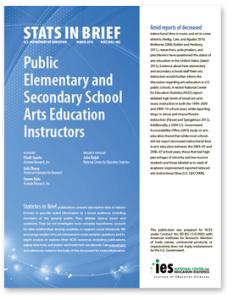
Author: U.S. Department of Education
Publication Year: 2015
Media Type: Report
Summary:
Statistics in Brief publications present descriptive data in tabular formats to provide useful information to a broad audience, including members of the general public. They address topical issues and questions. They do not investigate more complex hypotheses, account for inter-relationships among variables, or support causal inferences. We encourage readers who are interested in more complex questions and in-depth analysis to explore other NCES resources, including publications, online data tools, and public- and restricted-use datasets. See nces.ed.gov and references noted in the body of this document for more information.
Abstract:
While previous NCES reports have examined the availability of arts education to students and the incorporation of arts education into the school day, both during a single school year and across school years,1 this Statistics in Brief focuses on who teaches arts education in schools and how instructional staff varies by school characteristics and across school years in elementary and secondary school settings. Specifically, this report builds on the prior studies to explore the different types of school staff (i.e., full-time arts specialists, part-time arts specialists, and classroom teachers) used to provide arts instruction.2 “Arts specialists” refer to education professionals with a teaching certificate in an arts discipline—such as visual arts or music—who provide separate instruction in that discipline. “Classroom teachers” refer to teachers of self-contained classrooms; these teachers could teach arts areas as separate subjects or incorporate arts areas into other subjects.
The analyses in this brief rely on data from surveys of school principals conducted through the NCES Fast Response Survey System (FRSS): the “Elementary School Arts Education Survey” and the “Secondary School Arts Education Survey,” conducted in the 1999–2000 and 2009–10 school years.3 The elementary school survey asked principals whether various types of instructors—including arts specialists, classroom teachers, and other instructors—were available to teach arts subjects.4 The secondary school survey asked principals how many full-time and part-time teachers taught courses in various arts subjects.
This Statistics in Brief reports data only for schools that offered instruction in visual arts or music. Schools that did not provide instruction specifically in the visual arts were excluded from the analyses of visual arts instructors, and those that did not provide instruction specifically in music were excluded from the analyses of music instructors.
Both music and visual arts instruction were widely available in the school years examined in this analysis. In both 1999–2000 and 2009–10, approxi mately 94 percent of public elementary schools offered instruction specifically in music. Meanwhile, visual arts instruction was offered by 87 percent of public elementary schools in 1999–2000 and by 83 percent in 2009–10. At the secondary level, 90 percent of schools offered music instruction in 1998–99, as did 91 percent in 2008–09. Specific to visual arts, 93 percent of public secondary schools offered instruction in 1998–99 and 89 percent offered instruction in 2008–09 (Parsad and Spiegelman 2012).
The findings reported in this brief are statistically significant at the p < .05 level. No adjustments were made for multiple comparisons. For additional information about the data or methods used in this study, see the Technical Notes at the end of the brief. [Introduction, p. 1]
Arts & Intersections:
Categories: Arts Education
ADDITIONAL BIBLIOGRAPHICAL INFORMATION
PUBLISHER INFORMATION
Name: U.S. Department of Education, National Center for Education Statistics
Website URL: http://nces.ed.gov